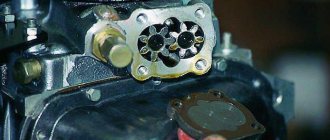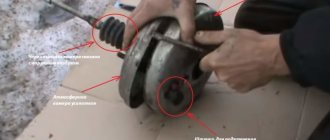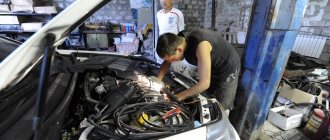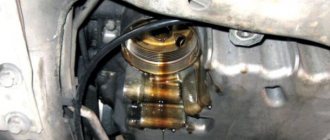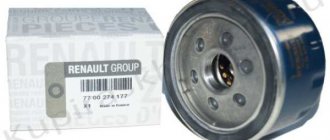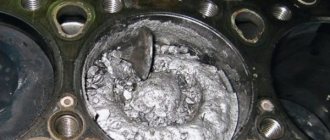Filter functions
Oil is required to continuously lubricate your car's engine. However, dirty liquid can cause significant damage to it. In other words, having a working oil filter is vital to maintaining engine performance.
This part performs several key functions:
- Cleans oil from contaminants such as metal particles and component oxides.
- Captures and holds debris until the filtration system is replaced.
- Helps avoid excessive hydraulic resistance and ensures clean oil is supplied to the engine for optimal engine performance.
By purchasing high-quality synthetic oils that are cleaner, the filter can last much longer. However, sooner or later the filter stops coping with oil contamination, and then the bypass valve comes to its aid.
FILTERS DEVICE
Oil filter
consists of a housing in which there is a filter element and, if necessary, bypass, anti-drainage and anti-drain valves.
Depending on the housing design, filters can be of two types: - non-separable (spin-on)
, which are currently most widespread due to their compactness, low cost and ease of replacement;
- dismountable (replaceable cartridge)
with a replaceable filter element, used less frequently, as they have increased dimensions and are less convenient to maintain.
In Fig: Non-separable oil filter 1 – housing; 2 – filter element (curtain); 3 – bypass valve; 4 – anti-drainage valve; 5 – anti-drain valve The filter element (“ curtain
This paper has high porosity, and thanks to its impregnation, it is durable, water- and oil-resistant.
To achieve the maximum possible filter surface area with minimal filter dimensions, the paper is laid in a special way, usually in the form of a multi-beam “star”. Volumetric filter elements made of cotton, synthetic and artificial fibers are used less frequently. A bypass valve
is sometimes called a safety valve, bypass valve, or bypass valve.
Its purpose is to ensure a guaranteed supply of engine oil to the engine lubrication system in the event that it cannot pass through the filter element if it is completely clogged or the oil viscosity is too high at low temperatures. The response pressure of the bypass valve is set depending on the engine design and is in the range of 0.55–2.6 kg/cm2 for different models. valve
prevents oil from draining from the filter and oil passages into the crankcase after the engine is stopped.
This eliminates the possibility of a delay in the supply of oil to the lubrication system due to the formation of an air lock during subsequent start-up. The most common design of an anti-drainage valve is a spring-loaded rubber disk that closes the inlet holes in the filter housing from the inside. An anti-syphon valve
is usually installed in permanent filters in combination with a bypass or anti-drain valve and prevents oil from pouring out of the housing through the outlet when replacing a used filter.
The absence of some valves in the filter
- the filter is placed on the engine so that oil cannot leak out of the housing, so there is no need for anti-drainage and anti-drain valves;
- The bypass valve is installed outside the filter directly on the engine.
Bypass valve task
Gradual clogging of the filter leads to a limitation of the liquid supply. Sometimes the oil pump is forced to supply more oil to the filter than it can process. Because not having the required volume of components to lubricate all the pistons can seriously damage your engine—and even dirty, unfiltered oil is better than nothing—quality modern filters are equipped with a bypass valve to ensure continuous fluid flow in all conditions.
For example, if the engine is not warmed up (cold oil has a thicker and viscous texture) or runs at high speeds (for example, when overtaking), not enough oil begins to pass through the filter. In this case, the bypass valve helps: it allows sufficient flow of engine oil to bypass the filter. The lubricating fluid itself is partially cleaned. If the filter is clogged, a pressure spring inside it is also activated, opening the bypass valve. When the engine is warm and running at moderate speed, the valve remains closed and the engine oil is completely filtered.
Despite the popular misconception, the key role in opening and closing the valve is played not by the pressure in the oil system itself, but by its differences. Specific indicators that trigger the device are indicated on the parts themselves. Typically, most valves operate at a pressure differential of 1 to 2 bar. Thus, the valve will remain closed even at extremely high absolute pressure levels in the system, if it has already established at a certain level. In this case, the oil continues to move towards the engine through the filter elements. This phenomenon also destroys the popular myth that the bypass valve can remain open for a long time: this violates the original principle of operation of the device and harms the entire oil system. After all, the engine will not work for long on dirty, unfiltered oil.
Thus, the main task of the bypass valve is to prevent “oil starvation” of the engine. Sometimes the oil system cannot cope with the load on its own. The engine and engine fluid did not have time to warm up in frosty weather, an attempt to overtake sharply increased the number of revolutions, and the oil filter even managed to become clogged? In such cases, the bypass valve, sacrificing the purity of the lubricating components, opens and provides the required fluid. However, it is worth understanding that this part will not be able to help out forever. Oil filters still play a key role in the entire engine lubrication system, so using high-quality motor oil and timely filter replacement will significantly extend the life of your car's engine.
GENERAL INFORMATION
Automotive oil filters
must meet the following requirements:
- have sufficient dirt holding capacity - the ability to retain and accumulate a significant amount of oil contaminants, which mainly depends on the size of the filter element and determines the service life of the filter;
- ensure optimal fineness of screening out contaminants - determined by the pore size of the filter element;
- have a small hydraulic resistance - to facilitate the supply of thickened oil to the rubbing vapors during a cold start of the engine;
- have sufficient strength of the housing and a reliable seal at the connection to the motor - in case of an emergency increase in pressure in the lubrication system or external mechanical influences.
Oil purification in the engine lubrication system can be carried out according to two main schemes:
— full-flow
– including one filter through which all the oil supplied by the oil pump is pumped;
In Fig: Full-flow diagram of the lubrication system of a car engine 1 – engine oil sump (pan); 2 – oil pump; 3 – full-flow oil filter
— combined
– including, in addition to a full-flow filter, a partial-flow filter or, in some cases, a centrifuge;
In Fig: Combined diagram of the lubrication system of a car engine 1 – engine oil sump (pan); 2 – oil pump; 3 – full-flow oil filter; 4 – partial flow filter
Main selection criteria
When choosing a new spare part, you should consider only high-quality items from reliable manufacturers.
When choosing a filter, you should adhere to the following basic criteria:
- durable metal case;
- high-quality sealing edge;
- perfect appearance, without any visible defects (cracks, scratches, chips);
- availability of certificates of quality, compliance and complete information about the manufacturer.
Important! You should not save when buying an oil filter, because it affects the stability and service life of the engine.
At what pressure should the pressure reducing valve operate?
But how can you understand that the pressure has increased or, conversely, decreased? And what should it even be like? The optimal oil pressure in the system can be found by looking at the owner's manual. It will be different for different brands and models of cars. For example, the pressure reducing valve of the Tavria oil pump operates at 0.55 MPa. Approximately the same indicators are relevant for most Lada cars.
You can measure oil pressure by connecting a special liquid pressure gauge to the system into the pressure sensor mounting socket. Before this, the engine must be warmed up to operating temperature. All measurements are made with the engine running.
Why do you need an oil pump pressure reducing valve?
As you know, oil is supplied to moving engine parts under a certain pressure created by a running pump. Without this, the lubricant would simply flow into the crankcase, exposing the elements of the crank and gas distribution mechanisms to increased friction and overheating. But too high a pressure is also dangerous for the engine. Gaskets, seals, seals are not able to withstand exceeding its normal values. Because of this, oil begins to ooze from under them, and can also enter the power and cooling system of the power unit.
It is to reduce the lubricant pressure in the system that the oil pump pressure reducing valve is designed. The word “reduction” itself is often used in mechanical engineering, denoting a reduction, reduction, or weakening of something. In our case, this refers to oil pressure.
Repair and adjustment of the oil pump pressure reducing valve
It is possible to understand whether the pressure reducing valve is suitable for further use only by dismantling it and disassembling it. This way it will be possible to diagnose all its elements. If there are deposits on the valve body, they must be washed off with gasoline, kerosene or carburetor cleaning fluid. It is also worth carefully inspecting the spring. If it shows signs of stretching, compression or deformation, it needs to be replaced.
When you have completely reassembled the valve, check its operation by simply pressing on the ball (piston). If it is pressed in with force and returns back, locking the housing channel, most likely the mechanism is working.
Adjustment of the oil pump pressure relief valve is carried out after the pressure relief valve is installed in the device body. The process is carried out by compressing or releasing the spring by unscrewing (twisting) the thrust screw. At the same time, oil pressure in the system is measured using a liquid pressure gauge. The adjustment, of course, is carried out with the engine not running, and the pressure measurement is carried out with the engine running.
Manufacturers and filter ratings
Currently, the situation in the niche of manufacturers of filter equipment for engine oil purification is as follows:
- leading brands reduce costs, improve the quality of materials, and use modern energy-efficient technologies;
- Despite approximately the same quality of products, there is a division of manufacturers - who is stepping on the heels of competitors, and who is stepping on the heels of more successful competitors.
Positions in the ranking may change, but it invariably contains companies with common characteristics:
- absolute compliance of products with the regulations of automobile companies and engine manufacturers;
- supplies for conveyors of large automakers;
- availability of dealer networks and products in retail stores;
- the presence of online, electronic and paper catalogs with an assortment for at least 75% of used car modifications;
- participation in exhibitions and availability of international IQNet certificates;
- partnership with leading producers of raw materials (glue, cellulose, synthetics, polymers, rolled metal).
Among car enthusiasts, ratings of specialized forums are quoted, the experts of which are the owners themselves, who are not interested in advertising specific brands, so new and used filters are sawed, real mileages from replacement to oil change and engine operating modes are indicated.
Regardless of the brand’s promotion and reputation, all manufacturers, without exception, are not able to cover 100% of the entire line they provide. On the one hand, filters of all sizes in the catalog indicate a serious attitude towards the consumer. On the other hand, production capacity is not enough to produce all items in the range, so some products are purchased from third-party, but proven and reliable manufacturers, and vice versa, some items are supplied to other companies, and they are assigned different logos, but with the obligatory indication of this fact.
For example, the manufacturer Filtron has 158 items in the catalog, its own products; the rest of the filters are labeled, for example, “made for Wix-Filtron”. That is, the filter was made by Wix to order from Filtron. This information is considered a trade secret of each manufacturer.
Thus, it is best to compile the rating for a specific car with a specific engine.
Ford Focus 2
The Mann W7015 filter with a bypass valve under the drainage elastic ring is considered the best. The filtration area is 0.64 m2, the profile of the sealing ring is square, and the engine oil filter cannot leak in principle. The placement of the curtain ribs is uniform, the fastening is strong, the density is of good quality. The connecting thread has a normal diameter and full profile.
The Fram PH3614 filter, which costs 1.5 times less, is slightly inferior to it. Filtration surface 0.63 m, polymer bypass valve, rigid drainage ring. The ribs of the curtains are laid unevenly, but the paper is of normal thickness.
Testing Mann and Fram filters for Ford Focus 2
Toyota Camry 40
The technical leader in the rating is the filter from the manufacturer Union Japan. Taking into account the quality of design and packaging, only Mahle is ahead of it. Taking into account the characteristics, design and cost, the data is summarized in the table:
Filter rating for Toyota Camry 40
All consumables were sawn, and the internal components were disassembled into individual elements before use:
10 filters disassembled
Kia Rio, Hyundai Getz and Accent
With little varying success in design, cost, build quality and performance, the leaders were:
- original Hyundai Kia;
- Nitto;
- Mann;
- JS Asakashi;
- Purflux.
The products of the Nevsky filter are inferior in all respects, but the declared service life of 7 – 10 thousand km is fulfilled by 4 points.
An overly bulky bypass valve in the Nevsky filter takes away useful space from the filter curtain.
Thus, when choosing an oil filter, the owner should take into account whether a diesel or injection engine is used in the car, the amount of lubricant, the operating pressure of the system and the location of the filter element. You can distinguish a fake by “clumsy” markings, incomplete threads, the absence of a rubber seal and the absence of a protective cup inside the curtain.
If you have any questions, leave them in the comments below the article. We or our visitors will be happy to answer them
Is it possible not to change the filter when changing the oil?
NO! It definitely needs to be changed! Why? YES, very simply, over an interval of 10 - 15,000 km, the oil filter becomes quite heavily clogged with all sorts of pollution elements. oil starvation of the engine after 20,000 km . AND THIS IS VERY BAD!
To restore filtration properly, you need to change the filter element, remember this mandatory condition!
Actually, that’s all, now for those who don’t want to read the video version of the article, it’s useful, watch it.
I’ll finish this, read our AUTOBLOG.
(
13 votes, average: 4.54 out of 5)
Similar news
Is it necessary to warm up the engine? Before the trip? Let's analyze winter and summer.
Sensors for an injection engine. Let's look at the VAZ as an example
The car won't start. Very detailed information about the starter, as well as others.
Source
Choosing the right oil filter
The most common oil filters can be very similar to each other. Considering that today many manufacturing and packaging companies offer consumables from different price categories, making the right choice is not so easy. A competent car enthusiast should know that when selecting filters, you should pay attention to the following parameters:
- Construction type;
- Cleaning method;
- Thread type (metric or inch);
- Bandwidth;
- Degree/quality of purification (nominal and absolute parameters are key);
- Bypass valve opening pressure.
The easiest way is to select a new filter using the code of the old consumable. To do this, you need to dismantle it and study the inscriptions on the case. If a car enthusiast cannot do this yet, then you can search for a spare part using the car’s parameters. These include:
- Make and model of the car;
- Engine parameters (including model, year of manufacture).
In certain cases, searching by VIN code is faster and more reliable, although in modern online stores the selection of the desired filter can be carried out using the so-called. the so-called full-text search, during which the buyer will fill in the “gaps” in information about the car with data from drop-down menus - this is also very fast, but does not exclude the human factor.
What is it made of?
Often we see a metal case, which is made in the shape of a cylinder. The upper part is just a dome, but the lower part has small holes in a circle, as well as a central one for threads.
But the filter element is not visible, it is located inside.
To be honest, the oil filter element is a very simple design; all the main work is done by special paper, which acts as a filter. It is located inside our cylindrical body, it is simply locked there.
There are also two valves - an anti-drainage valve (which prevents oil from flowing out of the filter) and a bypass valve (it relieves pressure when the oil is cold and cannot be filtered properly through the paper).
Here's the whole device, let's repeat it again:
- Filter element, usually special paper
- Two valves, bypass and anti-drainage
- Cylindrical, metal body
- The lower part has special holes through which dirty oil enters and clean oil is supplied; the central hole also serves for fastening (a thread is cut into it)
Separately, it is worth mentioning the submersible version, where only the filter itself (that is, the paper cartridge) is changed, as well as the rubber seals.
Purpose of the filter in the engine lubrication system
Filter location on the engine
During operation of the lubrication system, the oil cyclically passes through the main components and mechanisms of the engine, washing away carbon deposits, soot and other wear products from them. Removed contaminants, along with excess oil, end up in a sump (in wet sump systems) or in a special tank (in dry sump designs). In order for such oil to be used in subsequent cycles, it is very important to prevent waste from being re-entered into the system.
Determining where the oil filter is located in the system is not difficult. It is usually located at the bottom of the engine housing so that it can be easily replaced. Externally, it is a cylindrical body with a thread (black, blue, white or green), inside of which there is a filter element.

